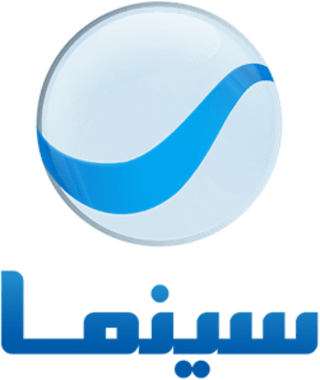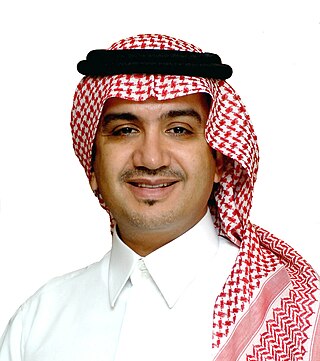Television in Saudi Arabia was introduced in 1965, but is now dominated by just five major companies: Middle East Broadcasting Center, SM Enterprise TV, Lebanese Broadcasting Corporation, Rotana and Saudi TV. Together, they control 80% of the pan-Arab broadcasting market. [1] Saudi Arabia is a major market for pan-Arab satellite and pay-TV. Saudi investors are behind the major networks MBC, which is based in Dubai, and Emirates based OSN. [2] [3] The Saudi government estimated that in 2000 the average Saudi spent 50% to 100% more time watching television than his or her European or US counterpart. [4] On average, 2.7 hours are spent daily watching TV in Saudi Arabia. [3]
The pay-TV market in Saudi Arabia is big, with a penetration estimated at 21%. beIN Sports is one of the largest pay-TV players in terms of subscriptions, with a market share of 59%.
The first television broadcasts in Saudi Arabia originated from a 200-watt television station, AJL-TV, "The Eye of the Desert". [5] These were English-language programs for the personnel of the USAF Dhahran Airfield, and started on 17 June 1955. [6] The programming was from contemporary American television, but all references to Christianity, Israel or alcohol were edited out. [5] In September 1957, ARAMCO began a television service for its 9,000 employees in Dhahran; that service would cease operations on 31 December 1998. [6] The first state owned television channel Al Saudiya would launch on 7 July 1965.
Nawal Baksh was the first Saudi woman to appear on Saudi television, in 1966.
Prior to the introduction of satellite broadcasting, Saudi TV channels One and Two had a reach of 60% of the adult Saudi population. The exception was with regard to Eastern Province audiences who traditionally tuned into Bahrain TV. [7]
Arab satellite first became available in 1985 with the launching of Arabsat, but it was not until the 1990s that satellite television became commercially viable. Accessibility of Western entertainment and news programs had a profound effect, as the foreign programs were instantly popular, leading Saudi TV to respond with more programs, including a live political talk show in which senior officials responded to questions by viewers. [8]
The first private satellite channel in the Arab world, the Middle East Broadcasting Centre, was founded in 1991. [8] In the early 1990s, King Fahd began to invest in the television business through Abdul Aziz Al Ibrahim and Khalid Al Ibrahim, the brothers of Al-Johara, his favourite wife. [9] Other private channels soon followed, led for the most part by Saudis and Lebanese. [8] By 2003, there were 15 private Arab satellite television channels, four of them owned by Saudis. [8]
By the mid-2000s, many women presented shows on Saudi television. [10] After trials in 2004 and 2005 in Jeddah, Digital Terrestrial Television launched in July 2006 and covered five major cities. To continue DTT transition and extend the service across the Kingdom, the Ministry of Culture and Information signed a contract with Thomson in May 2008. [11] By 2010, its network of 100 digital terrestrial broadcasting towers covered nearly 90% of the population. However, probably due to the adoption of multichannel TV on satellite, the uptake of DTT remains limited; in 2012 it was estimated at 1% of total households. [3]
The terrestrial broadcast sector in Saudi Arabia is state-owned through the Ministry of Media. [11] The state-run Broadcasting Services of the Kingdom of Saudi Arabia operates almost all domestic broadcasting outlets. [2] State-run television consists of four channels: Saudi One, the main channel in Arabic launched in 1963; [11] Saudi Two, an English language channel; Al Riyadiah, a sports channel; and the news channel Al Ekhbariya.
Government-owned terrestrial television has changed little since 1969. Its programming is still predominantly focused on educational, entertainment, and religious subjects. Reruns of Arabic-language cinema, particularly Egyptian movies, are also broadcast. Political content other than official government announcements has remained relatively limited. [8]
Kalam Nawaaem , a popular female-hosted Arabic talkshow discussing various societal topics, and Arab Idol , both showing on MBC, are the most popular TV programs in Saudi Arabia. Sada Al Malaeb , a sports talkshow, is the third preferred show. Turkish drama series also capture a strong following. [3]
Average daily reach, total Arab population, September 2021
| Position | Channel | Network |
|---|---|---|
| 1 | Al Arabiya | Middle East Broadcasting Center |
| 2 | MBC 1 | Middle East Broadcasting Center |
| 3 | Dubai TV | Dubai Media Incorporated |
| 4 | MBC Drama | Middle East Broadcasting Center |
| 5 | Saudi TV 1 | Saudi Broadcasting Authority |
| 6 | SSC | MBC |
| 7 | Rotana Khalijiah | Rotana Group |
| 8 | Al Ekhbaria | Saudi Broadcasting Authority |
| 9 | Iqraa TV | Orbit Showtime Network |
| 10 | Zee Alwan | Zee Entertainment Enterprises |
| 11 | B4U Aflam | B4U Network |
| 12 | Zee Live | Zee Entertainment Enterprises |
| 13 | Star Plus | Star India |

Abu Dhabi TV is an Emirates-based television channel that was originally launched in 1969. It broadcasts content from Abu Dhabi, the capital of the United Arab Emirates, and is owned by Abu Dhabi Media.

Saudi Aramco Residential Camp in Dhahran is a residential community built by Saudi Aramco for its employees to live in. It is located within the city of Dhahran in Saudi Arabia's Eastern Province. There are three areas recognized by the inhabitants in the Dhahran camp. The first built is known as the Main Camp. It is the oldest part and the busiest as it contains the commissary, various shops and parks, and infrastructure. The second area, known as the Hills, is the quietest since it is mostly residential and more family friendly. In 2017, a new residential area was opened and is known as Jebel Heights, it is an extension of the camp on the western edge of the facility. The area of Jebel Heights contains modern villas that vary from three bedroom houses to five bedroom houses as well as apartment blocks.
beIN Sports MENA is a subsidiary of beIN Sports. It is based in Doha, Qatar, serving the Middle East and North Africa (MENA) region. They are owned by beIN Media Group, a former subsidiary of Al Jazeera Media Network; the sports channels were spun off from Al Jazeera Media Network in December 2013. Following the spin-off, the channels' parent company was incorporated in January 2014 as their holding company. The channels primarily broadcast in Arabic, but it also offers feeds in English, French and Spanish.

MBC Group, formerly known as Middle East Broadcasting Center, is a Saudi state-owned media conglomerate based in the Middle East and North Africa region. Launched in London in 1991, the company moved its headquarters to Dubai in 2002 then moved to Riyadh in 2022.

Orbit Communications Company was a privately owned Pay TV network, operating in Bahrain. Owned by Saudi Arabia–based Mawarid Holding, it was the first fully digital, multi-channel, multi-lingual, pay television service in the Middle East and North Africa and was also the world's first fully end to end digital TV network. Launched in 1994, it was originally situated in Tor Sapienza, Rome, Italy as the location was considered entirely suitable to build a satellite farm. Orbit employed around 600 employees who were largely a combination of British and Italian staff with several Arabic speaking nations also represented. Orbit broadcast in several languages around the world including English, Arabic, French and Filipino.

Arab Radio and Television Network is an Arabic-language television network characterized by its multitude of channels. It is based in Jeddah, Saudi Arabia.

MTV Middle East, formerly MTV Arabia, was a free-to-air music television channel, and the Middle Eastern incarnation of MTV. As an addition to the MTV network, it was a joint venture between MTV Networks International and Arabian Television Network, a subsidiary of Arabian Broadcasting Network, and part of Arab Media Group, the largest media group in the United Arab Emirates. Launched as MTV Arabia, the channel was rebranded as MTV Middle East on August 30, 2011.
Rotana Media Group, commonly known as Rotana, is a Saudi Arabian entertainment company. It is primarily owned by Saudi prince Al Waleed bin Talal.
Mass media in Saudi Arabia provides unwavering support for the Mohammed bin Salman regime and routinely ignores negative reporting about the kingdom. Independent media are non-existent in Saudi Arabia. Outlets and journalists that fail to support the regime are subject to suspicion and repression.
Al-Resalah is an Arabic language satellite television channel "to present true Islam".
Television in Lebanon arose as a private initiative and not a state-institution. Lebanon was the first country in the Middle East & the Arab world to have indigenous television broadcasting. Various Arab televisions emulated the Lebanese model.

Rotana Cinema is a Saudi Arabian free-to-air satellite television channel owned by Rotana Group network. It was launched in 2004, and broadcasts exclusively old and contemporary Egyptian films.
Al Saudiya, is a Saudi news and entertainment TV channel broadcasting in Arabic, owned by the Saudi Broadcasting Authority (SBA), which is state-run and is administered by the Ministry of Media.
Al-Arab was a short-lived Arabic-language news channel which vowed to practice objective journalism. It was launched on 1 February 2015 and almost immediately shut down. The channel was owned by Saudi prince and entrepreneur Al-Waleed bin Talal, and was based in Manama, Bahrain.

Waleed bin Ibrahim Al Ibrahim is a Saudi Arabian businessman, and founder and chairman of Middle East Broadcasting Center, known as MBC Group.

Television in Egypt is mainly received through free satellite, while analog terrestrial represents 41% of total viewers. The Central Agency for Public Mobilisation and Statistics (CAPMAS) said the average time an Egyptian spends watching television a day is 180 minutes, while Egyptian channels recorded 170,000 hours of broadcast in 2019.
The General Organization of Radio and TV, also known in French as Organisation de la Radio et la Télévision Arabe Syrienne, is the state and public broadcaster in Syria and reports to the Ministry of Information. Earlier names were Radio and Television and Syrian Radio & Television (SRT).
Shahid is an Arabic content streaming platform operated by the Saudi state-owned MBC Group.
Channel 3, formerly known as H2ZZ-TV and corporately known as Saudi Aramco Television or just Aramco TV was a Saudi terrestrial television station owned by ARAMCO, which in its later years broadcast entirely in English. The station broadcast from the Saudi Aramco Residential Camp in Dhahran.